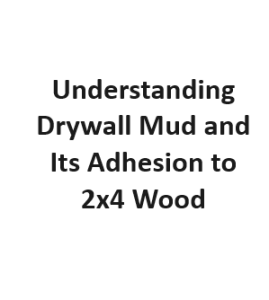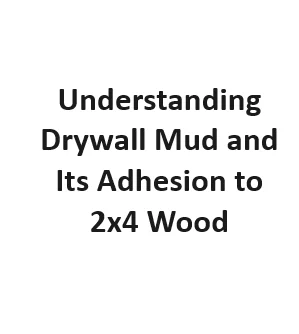When it comes to home construction and renovation, drywall is a common material used to create smooth, even walls. To achieve this, drywall mud is applied to cover joints and imperfections. But what if you’re working with 2×4 wood, and you need to apply drywall mud to it? Will it stick effectively? In this article, we’ll explore the factors that determine whether drywall mud will adhere to 2×4 wood.
The Nature of Drywall Mud
Drywall mud, also known as joint compound or mud, is specifically designed for adhering to drywall. It’s a versatile material that comes in different forms, such as ready-mixed or powdered. When applied to drywall, it dries to a smooth and paintable surface. However, its adhesion to other materials, like wood, can be different.
The Surface Preparation
One of the critical factors that determine whether drywall mud will stick to 2×4 wood is the preparation of the wood surface. Wood can be porous and may have natural oils, which can affect adhesion. Here’s what you can do to prepare the wood surface:
Sanding
Before applying drywall mud, sand the surface of the 2×4 wood. Sanding helps create a slightly rough texture, making it easier for the mud to adhere.
Cleaning
Ensure the wood is clean and free from dust, dirt, or any contaminants that might hinder adhesion. Use a damp cloth or a tack cloth to wipe down the surface.
The Type of Drywall Mud
The type of drywall mud you choose can also impact its adhesion to wood. There are three common types:
Lightweight Drywall Compound
Lightweight compound is excellent for embedding tape and the first layer of mud. However, it’s not the best choice for sticking to wood due to its lightweight composition.
All-Purpose Drywall Compound
This type is more versatile and can be used for various applications. It has better adhesion properties compared to lightweight compounds, making it a suitable choice for wood.
Setting-Type Drywall Compound
Setting-type compound, also known as hot mud, is quick-drying and offers excellent adhesion. It can be a good choice when working with wood, but you must work fast due to its fast-setting nature.
Application Techniques
The way you apply drywall mud to 2×4 wood matters. Use a putty knife or a trowel to spread a thin layer of mud evenly. Make sure to press it firmly into the wood surface to enhance adhesion. Multiple thin coats are better than one thick coat, as they dry more uniformly and adhere better.
Primer
Consider applying a primer to the wood surface before applying drywall mud. A primer can improve adhesion and ensure a smoother finish.
Maintenance
Once the drywall mud is applied and has dried, it’s essential to maintain the wood surface. Keep the area dry and free from excess moisture, as excessive moisture can weaken the bond.
Additional Tips and Considerations
Types of 2×4 Wood
The type of 2×4 wood you are working with can influence how well drywall mud adheres. Some woods are naturally more porous than others. For example, pine is relatively soft and can absorb moisture, potentially affecting adhesion. Hardwoods like oak, on the other hand, are denser and may provide a better surface for mud to stick.
Weather and Environmental Conditions
Environmental conditions can impact the adhesion of drywall mud to 2×4 wood. Extreme humidity, temperature fluctuations, and moisture levels in the air can affect the drying time and bond strength. It’s crucial to work in a controlled environment and consider weather conditions when working outdoors.
Sanding Between Coats
When working with wood, it’s advisable to lightly sand the surface between coats of drywall mud. This step ensures that subsequent layers adhere well and creates a smoother finish. Use fine-grit sandpaper and be gentle to avoid damaging the wood or removing too much mud.
Flexibility of Wood
Wood can expand and contract with changes in temperature and humidity. This movement can affect the adhesion of drywall mud over time. To mitigate this, it’s recommended to use a flexible mud or a setting-type compound that can better withstand such changes.
Durability
Consider the application when deciding if drywall mud is suitable for 2×4 wood. If the wood surface will be subject to heavy wear and tear, such as in high-traffic areas, it might be better to use alternative materials like wood putty or a veneer. These materials are specifically designed for wood surfaces and offer greater durability.
Testing
Before embarking on a larger project, it’s wise to perform a small-scale test on a piece of 2×4 wood to see how well the drywall mud adheres. This allows you to make any necessary adjustments to your technique or material choices before committing to a larger area.
Alternative Finishes
If you encounter challenges with drywall mud adhesion on 2×4 wood, you can explore alternative finishing options. These include using wood veneer, applying joint tape with wood putty, or using textured paint to achieve the desired surface appearance.
Safety Precautions
Remember to take safety precautions when working with drywall mud, which may contain compounds that can be harmful if inhaled or in contact with the skin. Wear appropriate safety gear, work in a well-ventilated area, and follow the manufacturer’s instructions.
Consult a Professional
If you are unsure about applying drywall mud to 2×4 wood or have a significant project, it may be a good idea to consult with a professional contractor or carpenter who can provide expert advice and assistance.
Types of Drywall Mud
| Type | Description | Drying Time | Application | Common Uses |
|---|---|---|---|---|
| Joint Compound | Used for taping and finishing drywall joints | Varies | Trowel or knife | Covering seams and joints |
| Lightweight Joint Compound | Contains lightweight materials | Quick | Easier spreading | Repairing minor imperfections |
| All-Purpose Compound | Versatile for various drywall tasks | Moderate | Trowel or knife | General drywall work |
| Setting Compound | Quick setting for faster jobs | Rapid | Trowel or pan | Quick repairs and small patches |
| Texture Compound | Adds texture to the drywall surface | Varies | Spray or trowel | Creating textured finishes |
Key Ingredients in Drywall Mud
| Ingredient | Role in Adhesion | Common Types | Characteristics | Adhesion to Wood 2×4 |
|---|---|---|---|---|
| Gypsum | Binder | Calcined and Synthetic | Main component, hardens as it dries | Good |
| Water | Mixing Agent | N/A | Activates the compound, adjusts consistency | Good |
| Fillers | Strengthener | Limestone, Perlite | Enhances durability and reduces shrinkage | Good |
| Polymers | Adhesion Enhancer | PVA, Acrylic | Improves bonding and flexibility | Good |
| Additives | Customization | Silica, Mica, etc. | Enhances specific properties | Variable |
Factors Affecting Adhesion to 2×4 Wood
| Factor | Influence on Adhesion | Notes |
|---|---|---|
| Surface Preparation | Crucial | Clean, dry, and roughen the wood for better adhesion |
| Type of Wood | Significant | Hardwoods vs. Softwoods may require different techniques |
| Drywall Mud Type | Important | Different compounds have varying adhesion properties |
| Temperature and Humidity | Affects Drying Time | Dry conditions promote adhesion |
| Application Technique | Technique-dependent | Proper technique ensures consistent adhesion |
Testing Adhesion Strength
| Test Method | Procedure | Results Interpretation |
|---|---|---|
| Cross-Cut Adhesion Test | Make cuts in the compound and assess adhesion | Higher number of intact squares is better |
| Pull-Off Test | Measure force required to pull mud from wood | Higher force indicates better adhesion |
| Shear Strength Test | Apply lateral force to assess bond strength | Greater resistance suggests good adhesion |
| Salt Spray Test | Expose samples to saltwater mist for corrosion resistance | No corrosion indicates strong adhesion |
| Freeze-Thaw Test | Subject samples to freeze and thaw cycles | Minimal separation implies good adhesion |
Tips for Improving Adhesion
| Tip | Description |
|---|---|
| Proper Surface Preparation | Clean, dry, and roughen the wood surface |
| Selecting the Right Drywall Mud | Choose the type suitable for your project |
| Quality Application Techniques | Ensure even and adequate mud application |
| Controlled Environmental Factors | Maintain consistent temperature and humidity |
| Testing Adhesion Strength | Perform tests to confirm strong adhesion |
Final Thoughts
In summary, while applying drywall mud to 2×4 wood can be a viable option, it requires careful consideration, preparation, and technique. By addressing the factors discussed in this article and taking the necessary steps, you can achieve a successful and durable finish on wood surfaces. The key is to approach the project methodically and ensure that the materials and methods you choose are suitable for your specific needs.
Remember, the success of your project depends on your attention to detail, from the type of wood you use to the type of drywall mud and the techniques employed. With the right approach, you can create a seamless and professional finish on 2×4 wood surfaces.

